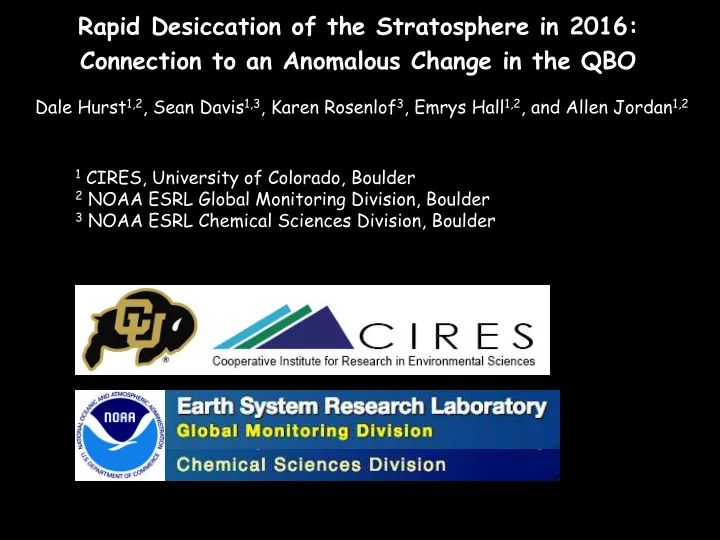

Rapid Desiccation of the Stratosphere in 2016: Connection to an Anomalous Change in the QBO Dale Hurst 1,2 , Sean Davis 1,3 , Karen Rosenlof 3 , Emrys Hall 1,2 , and Allen Jordan 1,2 1 CIRES, University of Colorado, Boulder 2 NOAA ESRL Global Monitoring Division, Boulder 3 NOAA ESRL Chemical Sciences Division, Boulder
Why is stratospheric water vapor important? <1% of atmospheric water vapor resides in the stratosphere. How can changes in stratospheric WV affect climate? The flux of outgoing longwave radiation (OLR) is very sensitive to changes in WV abundance near the tropopause. A 10% increase in water vapor near the tropopause reduces the OLR flux by approximately 1 W•m -2 Jensen et al. (1999) ~1 ppmv increase (~25%) in stratospheric WV between 1980 and 2000 would have enhanced the rate of surface warming in the 1990s by ~30% Solomon et al. (2010) Stratospheric WV also influences: Stratospheric ozone chemistry • halogen activation (HOx), O 3 reaction rates, polar O 3 chemistry (PSCs) Lifetimes of greenhouse and ozone-depleting gases (OH, T) Cirrus cloud formation
What controls the amount of WV entering the stratosphere? Other Contributors • Transport through tropopause breaks • Ice lofting by deep convection • Asian Monsoon (?) In Situ Production • Oxidation of stratospheric CH 4 and H 2
Annual Cycles and Anomalies, 15°S-15°N Zonal Means ∆ H 2 O = -1.9 ppmv ∆ CPT = -2.5 °C
Quasi-Biennial Oscillation (QBO) Downward propagating zonal wind shift in the tropical stratosphere 30 50 70 Avg Period 28 months 30 27 Cycles 1953-2015 50 70 Zonal Wind Speed (Singapore, m/s) 30 Singapore 50 E W 70
Water Vapor Anomalies and QBO Index 1 2 3 4 5 6 QBO Index (U 50 -U 70 ) is a gauge of the shear in zonal winds in the tropical stratosphere. The QBO is typically zonally uniform. 6 distinct QBO cycles 2004-2016
Water Vapor Anomalies, QBO cycles 1-6 Cycle 6 ∆ H2O anom -1.9 ppmv in 1 yr ~50% of burden!
Tropical Water Vapor Anomaly Maps, 83 hPa December 2015 10°S 5°S 0° 5°N WV anomalies are zonally asymmetric! 10°N 0° 60°E 120°E 180° 120°W 60°W December 2016 10°S 5°S 0° 5°N 10°N Largest changes in the E Hemisphere 0° 60°E 120°E 180° 120°W 60°W
MERRA2 Coldpoint Temperature Anomaly Maps December 2015 15°S 0° 15°N A B D C Strong El Niño – SST + SST – Upwelling + + CPT Upwelling – CPT 0° 60°E 120°E 180° 120°W 60°W November 2016 15°S 0° 15°N Weak La Niña + SST - SST + - Upwelling Upwelling + CPT – CPT 0° 60°E 120°E 180° 120°W 60°W
Meridional WV Anomalies, QBO cycles 1-6 B A C D
Meridional WV Anomalies, QBO cycles 1-6 A B C D
Summary Tropical lower stratospheric WV closely follows tropical CPTs Zonal average anomalies dropped 1.9 ppmv and 2.5°C in only 11 months (Dec 2015 - Nov 2016) The anomalous behavior of the 2015-16 QBO cooled the tropical tropopause earlier than normal seasonal cooling The 2016 changes in WV and CPTs were not zonally uniform • Transition from strong El Niño to weak La Niña Lower stratospheric WV anomalies over the E Hemisphere tropics dropped 2.7 ppmv in 11 months!!! Photo by Patrick Cullis, CIRES
Extra Slides
MLS WV 83 hPa and MERRA2 CPT Anomaly Maps December 2015 10°S 5°S 0° 5°N 10°N 0° 60°E 120°E 180° 120°W 60°W December 2015 15°S 0° 15°N 0° 60°E 120°E 180° 120°W 60°W
MLS WV 83 hPa and MERRA2 CPT Anomaly Maps December 2016 10°S 5°S 0° 5°N 10°N 0° 60°E 120°E 180° 120°W 60°W November 2016 15°S 0° 15°N 0° 60°E 120°E 180° 120°W 60°W
Recommend
More recommend